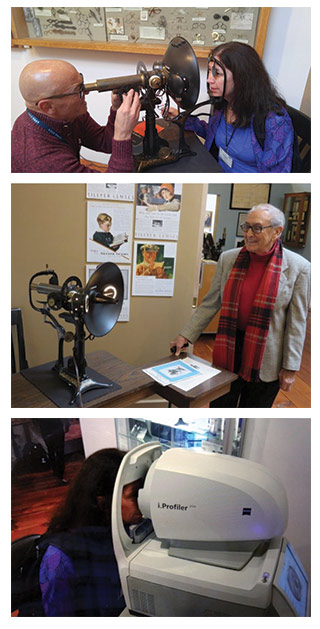 On Nov. 4, Diane Matuck and I gave an ABO certified course that included a tour of the Optical Heritage Museum during the Opticians Association of Massachusetts Annual meeting in Southbridge. Diane serves on the Board of the Museum and on the OAM Board. During the course and subsequent open house tour that day, we highlighted noteworthy inventions of measurement devices in the collection.
On Nov. 4, Diane Matuck and I gave an ABO certified course that included a tour of the Optical Heritage Museum during the Opticians Association of Massachusetts Annual meeting in Southbridge. Diane serves on the Board of the Museum and on the OAM Board. During the course and subsequent open house tour that day, we highlighted noteworthy inventions of measurement devices in the collection. One item that always attracts attention is an 1898 C.I. Ophthalmometer, donated by Dr. Leonard Simonelli (shown next to the device in the upper right photo). He recalled that its original owner also practiced in Southbridge when it was originally purchased, and the unit never left town during its use.
The device measures the radius of curvature of the cornea, and the output readings provide the “k values” from which the radius of curvature can be computed. In researching the history of the Ophthalmometer, I learned that the device was invented in 1851 by Hermann von Hemholtz and is often referred to as a keratometer. It was the first device to quantify corneal topography of the eye. Looking back at the engineering of the unit, I marvel at what was done before computers and CAD systems were available to aid in the engineering of such a device! During the tour, Massachusetts optician Tom Miner stopped to admire it. He told us he had experience using one, and we were all curious to see if he could demonstrate how it operates. He sat down to measure Diane’s eye. He took a few moments to reacquaint himself with our antique unit and determined a k reading of 46.75. While the conditions for taking the reading were not optimum, it was fun to have this 119-year-old unit provide a measurement.
Around the corner in the Museum sits a complete Zeiss lane of modern diagnostic equipment that showcases the latest in Zeiss refraction technology. It was natural to have Diane retested using today’s latest technology. Zeiss rep Ryan Bean took a complete eye profile of Diane using the Zeiss i-Profiler. We were curious to see if the k values obtained were at all similar to those from the Ophthalmometer. Interestingly, there was good agreement on the readings with a 46.50 result on the Zeiss unit. The k values of 46.50 versus 46.75 equate to radii of curvature of 7.25 mm versus 7.20 mm, which show good agreement. While this was a social setting and not a true scientific comparison, we enjoyed seeing how the old and new technology matched so closely.













